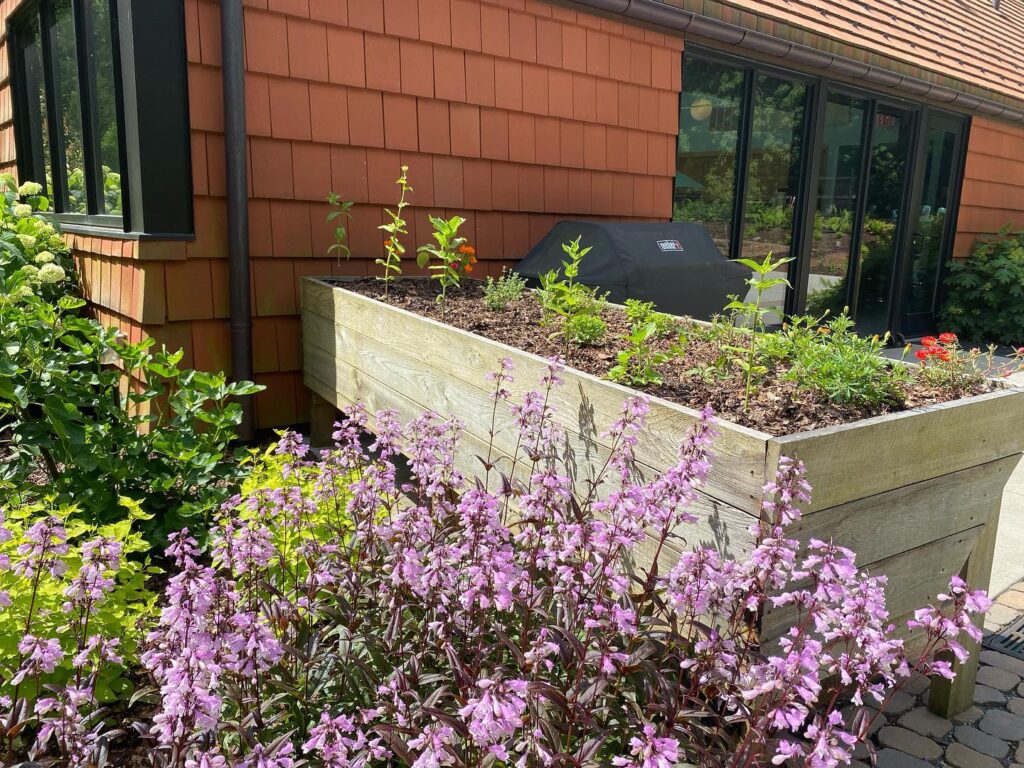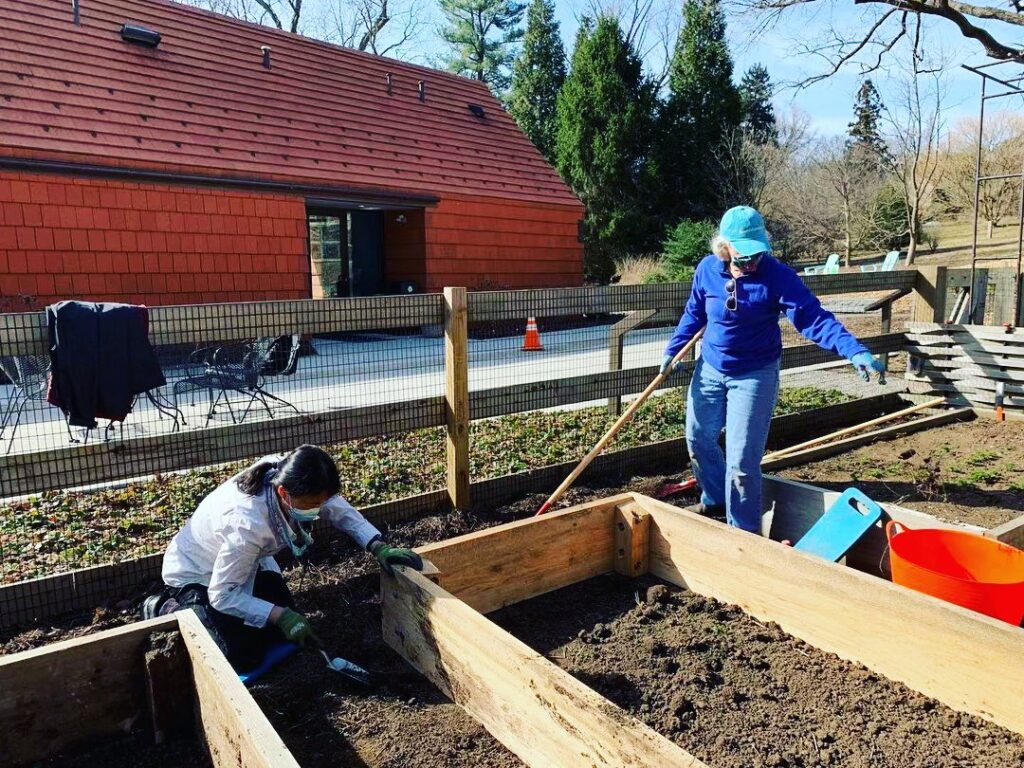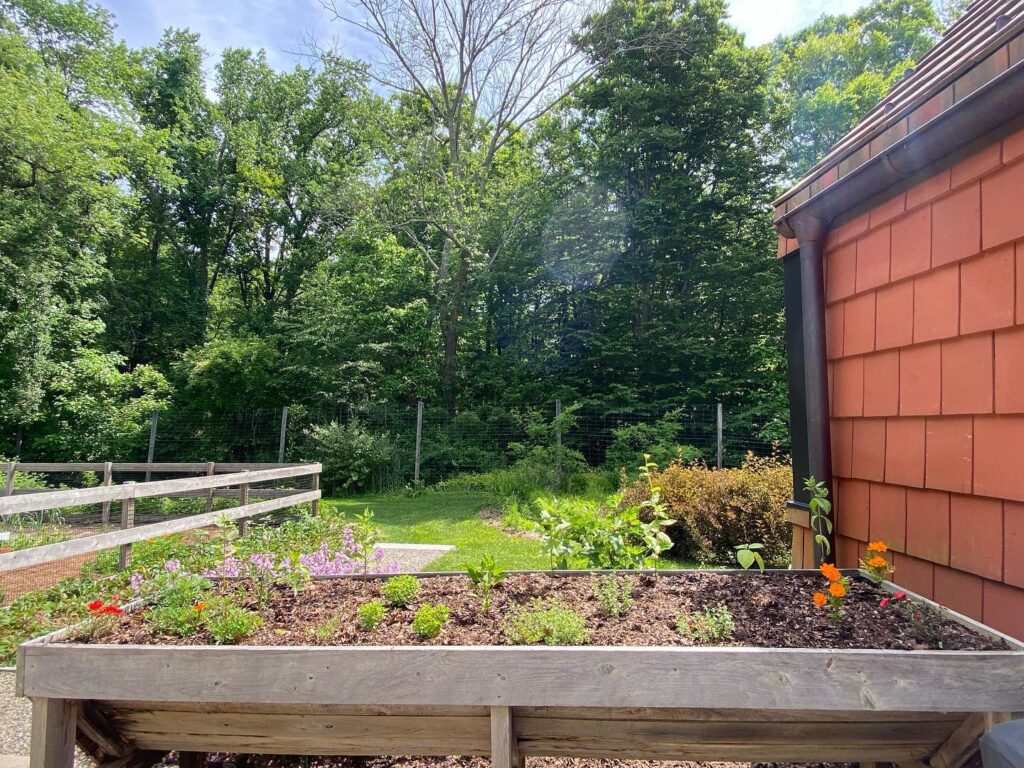Why use raised beds? Raised beds are ideal when you need to create more useable garden space, and your current space is limited, or soil is of poor quality or contaminated. You will also get a longer growing season with raised beds since the soil is warmer than the soil in the ground. In addition, there is better soil structure and improved drainage. When a raised bed is planted densely, it can also mean less water evaporation and fewer weeds!
Building a Raised Bed
Raised beds are typically 8-12 inches high, which will allow for adequate root development. Eighteen inches is the perfect seating height if you would like to make working in the garden easier on your knees and back, and it will allow you to garden while seated in a chair.
Your bed width can be what ever works for your space – we recommend no more than 4 feet so you can easily reach across to harvest and weed. Optionally, you can line the bed with hardware cloth to prevent burrowing animals from damaging your garden.
Build your raised bed from hardwood planks of black locust, cedar, Osage orange, redwood, or oak. They are not entirely rot-resistant but will last longer and be safe. Do not use pressure-treated wood or railroad ties for your raised bed due to possible leaching of toxic chemicals. Install three-inch galvanized screws halfway down the wood to prevent the wood from bowing when filled with soil. For a tutorial on building your own raised bed, visit Penn State Extension.
Other materials for making a raised bed include bricks, concrete blocks, rocks, stones, galvanized steel (with drainage holes in the bottom), hay bales, and grow bags. Don’t be afraid to be creative!
Soil for a Raised Bed
Choose a mix that has good nutrient and water-holding capacity. A soil and compost mix is recommended at a 70% soil to a 30% compost ratio. Some recommend 60% topsoil, 30% compost, and 10% potting soil (a soilless growing mix that contains peat moss, perlite and/or vermiculite). If you do not have access to quality topsoil, an acceptable substitute is a 50-50 blend of a soilless growing medium called “potting soil” and compost. You can find these supplies at most garden centers. Consider going in on a bulk delivery with a friend or neighbor to save on cost, and reach out to local farms and townships to see what compost resources exist in your area.
Laying out a Raised Bed
Locate the bed so it will receive six to eight hours of sun. Determine the north-south axis of the site and lay out the beds either in a north-south or east-west direction. Try to avoid diagonal beds where possible.
Tending Your Raised Bed
Planting intensively (close together) keeps weeds to a minimum. You may need to weed a little every week in early spring, but your weeding chores should be significantly reduced by mid-summer. Remove weeds quickly when they crop up, so your vegetables and herbs aren’t competing for moisture, nutrients, and root space.
Crops that grow for three to four months will benefit from a granular all-purpose organic fertilizer both at the initial time of planting and a second application at midseason. Alternatively, you can use homemade compost or compost tea.
When it comes to watering, if Mother Nature has not provided an inch of rain per week, then it is up to us to ensure the plants get the water they need to thrive. The best way to monitor soil moisture is with our hands. It should feel slightly damp if you stick a finger down into the soil for about three inches. Planting intensively helps shade the soil surface, and dense planting helps protect from the wind. Mulching around plants with two to three inches of shredded leaves or straw is another way to retain moisture and add organic matter to the soil. Don’t let the soil dry out completely to keep your plants healthy. Water-stressed plants can have root hairs die back, thus, the plants’ energy is put into regrowing them instead of producing fruit. In addition, water-stressed plants can become bitter and tough.
Elevated Raised Beds
Gardening in elevated raised beds combines container gardening and raised bed gardening. Traditional raised beds lack a bottom and are reasonably large (ex., 4′ wide x 8′ long). Elevated raised beds have a base to contain the soil and are far smaller than a raised bed. Elevated raised bed gardening combines the best of both worlds. Raised beds give the gardener a literal leg-up by raising the planting area to work height.
Locate your elevated raised bed in a spot with six to eight hours of sunlight. It will be too heavy to move once filled with soil, so make sure you’re happy with its location. Try to place it near a spigot with a hose for easy watering! Fill with soil that is 2/3 potting mix and 1/3 compost. You may want to toss in a few handfuls of organic granular fertilizer.
When planting in an elevated raised bed, use compact vegetable varieties like “Tumbling Tom” tomatoes, “Fairy Tale” eggplants, “Mohawk Patio” peppers, and “Thumbelina” carrots, as well as small-saturated berry plants such as “Strawberry Shortcake” red raspberries and ‘Top Hat’ blueberries and strawberries.
Remember, there are no gardening mistakes, only experiments. Given that, we hope you will experiment with raised beds and, in so doing, find a new or revived love of gardening.









